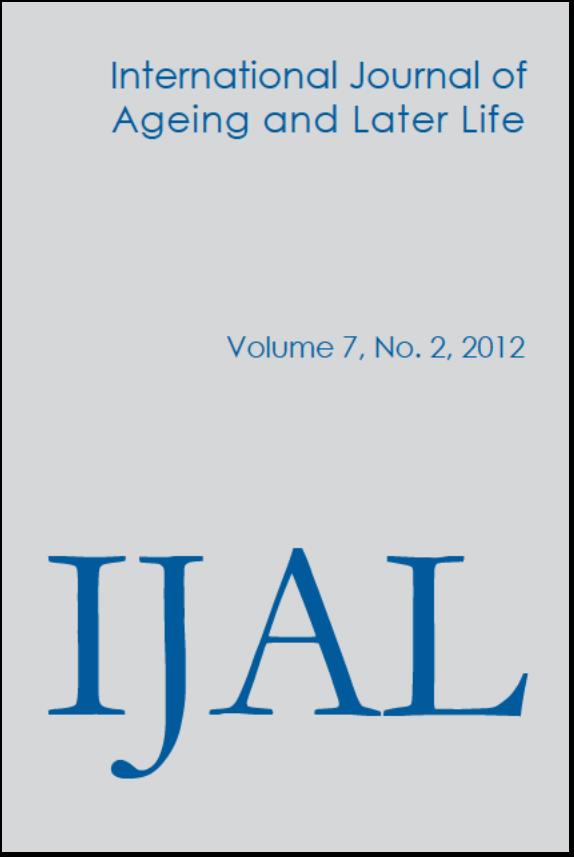“The play’s the thing”: theatre as a scholarly meeting ground in age studies
Main Article Content
Abstract
Addressing three current critical turns in gerontology, this article proposes the theatre as a fertile ground for various theoretical angles in age studies - including the performative on and off stage, the narrative in the script and the critical questioning of age and ageism in the multiple realities of performance. Beginning from a shared site in the theatre, researchers may be able to establish greater common ground, resulting not only in multi-disciplinary efforts but also in truly interdisciplinary work. With a foundation in performance studies, this article suggests promising directions for age studies and theatre scholarship by examining three aspects of theatrical production: a play script, Jan de Hartog’s popular The Fourposter (1951); a collaborative development of a script and production, Jeanette Mathewes Stevens’ 2010 senior drama ElderSpeak; and a performance, a 2011 song-and-dance revue staged by an established senior theatre troupe, the Sarasota Senior Theater.
Metrics
Article Details

This work is licensed under a Creative Commons Attribution-NonCommercial 3.0 Unported License.
Since 2020 the International Journal of Ageing and Later Life uses a Creative Commons: Attribution license, which allows users to distribute the work and to reform or build upon it without the author's permission. Full reference to the author must be given.
References
Auslander, P. (1997). From Acting to Performance: Essays in Modernism and Postmodernism. New York: Routledge. DOI: 10.4324/9780203444269
Basting, A. D. (1998). The Stages of Age: Performing Age in Contemporary American Culture. Ann Arbor: The University of Michigan Press.
Basting, A. D. (2000). Performance studies and age. In T. R. Cole, R. Kastenbaum & R. E. Ray (eds.), Handbook of the Humanities and Aging (pp. 258–271). New York: Springer.
Broadway League. (2012). The Internet broadway database. Available on http://www.ibdb.com (Accessed: May 15, 2012).
Butler, J. (1990). Gender Trouble: Feminism and the Subversion of Identity. New York: Routledge.
Deats, S. M. & Lenker, L. T. (eds.). (1991). Aging and Identity: A Humanities Perspective. Westport, CT: Praeger.
De Hartog, J. (1951). The Fourposter. New York: Random House.
Freeman, P. & Nelson, M. (1989). 6,500 I Dos make for one sturdy marriage for Susan Goeppinger and fellow actor David Anders. People 31(17).
Fries-Dieckmann, M. (2009). Performing old age on stage: Selected plays by Beckett, Pinter and Stoppard. In H. Hartung & R. Maierhofer (eds.), Narratives of Life: Mediating Age (pp. 183–195). Berlin: Lit Verlag.
Gullette, M. M. (2004). Aged by Culture. Chicago: University of Chicago Press.
Gullette, M. M. (2011). Agewise. Chicago: University of Chicago Press.
Hartung, H. & Maierhofer, R. (eds.). (2009). Narratives of Life: Mediating Age. Berlin: Lit Verlag.
Hennessy, C. H. & Walker, A. (2011). Promoting multi-disciplinary and inter-disciplinary ageing research in the United Kingdom. Ageing & Society 31(1): 52–69. DOI: 10.1017/S0144686X1000067X
Holstein, M. B. & Minkler, M. (2003). Self, society, and the new gerontology. Gerontologist 43(6): 787–796. DOI: 10.1093/geront/43.6.787 PMid:14704376
Katz, S. (2000). Busy bodies: Activity, aging, and the management of everyday life. Journal of Aging Studies 14(2): 135–152. DOI: 10.1016/S0890-4065(00)80008-0
Knoxville-Knox County Community Action Committee Office on Aging. (2011). Available on http://www.knoxseniors.org/about.html (Accessed: November 20, 2011).
Lenker, L. T. & Lipscomb, V. B. (2002). Reflections of the aging Caesar: Drama as cultural perspective. Journal of Aging and Identity 7(4): 275–286. DOI: 10.1023/A:1020765621933
Lipscomb, V. B. & Marshall, L. (eds.). (2010). Staging Age: The Performance of Age in Theatre, Dance, and Film. New York: Palgrave.
Loxley, J. (2007). Performativity. London: Routledge.
Miller, A. (1996). Death of a Salesman. New York: Viking.
Noice, H. & Noice, T. (2009). An arts intervention for older adults living in subsidized retirement homes. Aging, Neuropsychology, and Cognition 16(1): 56–79. DOI: 10.1080/13825580802233400 PMid:18686051 PMCid:2769921
Sarasota Senior Theater. (2011). Available on http://www. sarasotaseniortheater.com (Accessed: September 20, 2011).
Schechner, R. (1985). Between Theatre and Anthropology. Philadelphia: University of Pennsylvania Press.
Schechner, R. (1989). Race free, gender free, body-type free, age free casting. The Drama Review 33(1): 4–12. DOI: 10.2307/1145934
Schechner, R. (2001). Performance studies in/for the 21st century. Anthropology and Humanism 26(2): 158–166. DOI: 10.1525/ahu.2001.26.2.158
Shakespeare, W. (2008). Hamlet. In The Norton Shakespeare, Based on the Oxford Edition, 2nd ed., gen. ed. Stephen Greenblatt. New York: W. W. Norton.
Stalpaert, C. (2012). Staging age and aging in The Rite of Spring: Reconstruction or critical intervention? In A. Swinnen & J. A. Stotesbury (eds.), Aging, Performance and Stardom. Doing Age on the Stage of Consumerist Culture (pp. 53–74). Wien: LITVerlag.
Stevens, J. M. (2010). ElderSpeak. Portland, OR: ArtAge.
Strimling, A. (2004). Roots & Branches: Creating Intergenerational Theatre. Portsmouth, NH: Heinemann.
Swinnen, A. (2011). Introduction to the Conference Theorizing Age: Challenging the Disciplines. Program Overview. Maastricht University.
The Penelope Project. (2011). Available on http://penelopeproject.wordpress.com/about/ (Accessed: November 2, 2011).
Thompson, J. & Schechner, R. (2004). Why social theatre? The Drama Review 48(3): 11–16.
Thomson, D. (2009). Are we there yet?: Challenging notions of age and aging through intergenerational performance. Journal of Aging, Humanities, and the Arts 3(2): 115–133. DOI: 10.1162/1054204041667767
Vogel, P. (1997). The Mammary Plays: How I Learned to Drive and The Minneola Twins. New York: Theatre Communications Group.
Vorenberg, B. (2011). The New Senior Theatre Survey. Available on http://www.seniortheatre.com (Accessed: November 15, 2011).
Wilder, T. (1957). Our Town. In Three Plays by Thornton Wilder. New York: Bantam.
Woodward, K. (1991). Aging and Its Discontents. Bloomington: Indiana University Press.
Zeilig, H. (2012). The critical use of narrative and literature in gerontology. International Journal of Ageing and Later Life 6(2): 7–37. DOI: 10.3384/ijal.1652-8670.11627





